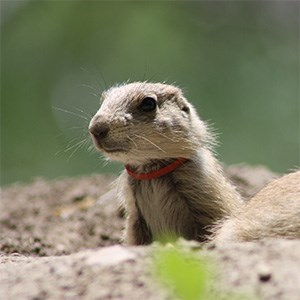|
Visitors to national park sites like Devils Tower have opportunities to view wild animals in their natural habitat. With that opportunity comes responsibility: keeping those animals wild. Below you can find tips regarding wildlife viewing, as well as the proper behavior you should adopt for safe and responsible wildlife encounters. You can also watch a short video on keeping the wild in wildlife. Whatever the scenario, remember that wild animals should not be fed, touched or harassed. We are visiting their home - be respectful. 
NPS / Philip Knecht Viewing DistanceMost wild animals have a natural fear of people. Animals in national parks may lose this fear if they have frequent encounters with humans. These wild animals can still act unpredictably. For visitor and wildlife safety, maintain proper viewing distance. This is 50 feet (15 meters) for small mammals, birds, reptiles, etc, and 100 feet (30 meters) for large animals such as deer. If an animal approaches you, back away to maintain distance.Photographing WildlifeKeep the above viewing distance guidelines in mind when photographing wildlife. The popularity of "selfies" and desire to get the "perfect shot" has led to dangerous encounters between people and wild animals. Enjoy wildlife with your eyes; if you have to get a picture, use a zoom or telephoto lense.Interacting with WildlifeCalling, clicking, whistling, or making other noises to attract wildlife is considered harassment. Feeding wildlife is illegal. Avoid unintentional feeding by storing food properly (in your car or in a designated food storage device) and properly disposing of your trash.Why Can't I Feed the Prairie Dogs?The ways visitors have chosen to interact with the prairie dogs at Devils Tower National Monument have created several issues. Feeding prairie dogs is a danger to yourself, the animals and other visitors. Feeding an animal causes it to lose its natural fear of humans, and over time expect a food reward for approaching humans. This is called habituation.Prairie dogs are ground squirrels, and like all rodents have very sharp front teeth. They can and do bite people who try to feed them. Like all mammals, prairie dogs can carry diseases such as plague and tularemia. They are hosts to insects and arachnids (e.g. lice and ticks) that transmit these diseases. Approaching these creatures may expose yourself to bites and/or disease transmission. A habituated prairie dog will expect a person to feed it. Tossing food into prairie dog town may seem safe and innocent, but the next visitor to approach those prairie dogs is now at a higher risk because of the unsafe behavior of previous visitors. Furthermore, human food can be unhealthy for wild animals, and may contribute to their illness or death. At Devils Tower, prairie dogs near the park road (which are more likely to be fed) weigh about 50% more than prairie dogs which live farther from the road. The park road traverses directly through our prairie dog town. Prairie dogs will naturally cross the road seeking out new territory or mates; vehicles cause a high number of fatalities of many animals within the park. Habituated prairie dogs will spend more time near the road, increasing their chance of being killed by a vehicle. |
Last updated: April 24, 2025
